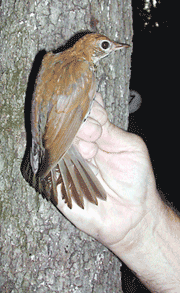 |
|||||||||||
|
|||||||||||
|
|||||||||||
A Bird in the Hand
|
|||||||||||
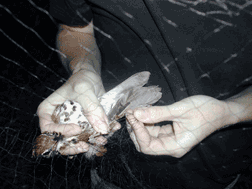 |
Keri Parker disentangles a young wood thrush from the fine mesh of a woodland net,. After measuring, weighing and checking his plumage, Parker bands and releases the bird. |
I was looking forward to holding a bird again. Memories of banding birds in Massachusetts 25 years ago lingered in my hands: the sharp nip of cardinals, the kitten-softness of screech owls, the immense power of swans.
On this morning, experienced bander Keri Parker disentangled a young wood thrush from the fine mesh of a woodland net. After measuring, weighing and checking his plumage, she handed him to me.
Quiet as a sigh, his soft chestnut back nestled in my palm. Rich dark eyes peered from his buff-tinged head. His snow-white breast and belly were dotted with sooty spots; the pale streaks washing over his back attested to his youth. An adult thrush called repeatedly from a nearby tree; perhaps his mother. My moment over, I opened my hand and let the baby go. He hopped and fluttered, still learning the challenges of flight.
This wood thrush was one of six we would band that morning, bringing the total for the summer to 21: almost double the number banded in 2005. This total delighted Sandy Teliak, a three-year volunteer on the project who spends hours compiling the data. In most parts of its range, the wood thrush population has been decreasing since the 1970s. Jug Bay was doing something right.
The Dawn Patrol
A yellow-billed cuckoo’s low hollow cluck resounded through the understory as we walked the circuit of nets. A renowned devourer of tent caterpillars, this bird is a welcome addition to any woods.
“Ah,” said Natasha Hagemeyer, a 2006 graduate of Severna Park High School then planning to study biology at the University of Maryland Baltimore County. “That’s one call I know!”
Introduced to bird banding at Greenbury Point with the Christian conservation group A-Roche, Hagemeyer soon began volunteering at Jug Bay as well. She brought along her younger sister Julia, who was equally fascinated.
Getting teenagers up early, especially in summer, is always a challenge. For these teens, the promise of birds was enough.
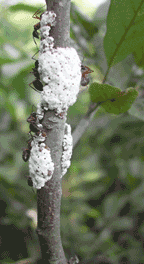 |
ants feed on a froth of juice released from an alder tree by chewing aphids. |
“It’s worth getting up at 4:45am,” said Julia, a freshman at Severna Park High. “We got here early, so we took a walk along the Railroad Bed Trail and were watching ospreys when a hummingbird came by and was eating the wild rice flowers.”
“There’s always a reason to get up at o-dark 30,” said Teliak. “You come here knowing you’re going to get hot and sweaty, and you know you’ll get wood thrush and yellowthroats and wrens, but there’s always something that makes it worth getting up so early. Today, it was a juvenile hooded warbler.”
We had just begun the second of six rounds when we came upon the recently hatched hooded warbler, a species not regularly caught. His yellow face peered out from his black balaclava hood above his equally yellow breast and olive-green back. His outer tail feathers flashed with white.
Earlier in the year, the presence of brown-headed cowbirds caused the researchers to fear for the breeding success of some of the smaller birds. Cowbirds parasitize smaller songbirds by laying their eggs in the warblers’ nests. The larger eggs of the cowbirds hatch earlier, and the young warblers often do not survive. The little warbler was fortunate; his parents had beaten the odds.
Unwelcome Surprise
Anticipation gets the banders up early, but the surprises are not always welcome.
With the heat pressing through the still foliage, we walked briskly to each row of nets, not wanting the birds entangled too long. Heat can exhaust a bird in a net, though none had been affected so far. Teliak, mopping his face with a towel, remained resolute.
“The safety of the birds is paramount,” he said. “Sometimes we have even found a box turtle eating a bird in the net.”
I gasped, having never heard of this before. Keri Parker, who had worked at the Powdermill Nature Reserve’s bird banding station in Rector, Pennsylvania, had seen even more.
“And not only turtles,” said Parker. “I’ve seen chipmunks jumping for birds, and even deer walking net lines munching at birds.”
Rounding the corner to the next net, we looked at each other in amazement when Quinlan called, “We’ve got a turtle eating a bird here.”
Deft hands quickly freed the desperate wood thrush hanging low in the bottom of the net. Chris Swarth, the director of Jug Bay Wetlands Sanctuary, who began the banding program here 16 years ago, has seen three birds killed by turtles.
Fortunately for this thrush, rescuers arrived in time. Removing the hungry turtle, the banders instantly released the wood thrush, not wanting to subject the bird to any further stress by weighing and measuring it.
Later, Swarth asked if anyone noticed the plumage, whether it had the buffy-edged head and back feathers of a juvenile or the clean rusty wash of an adult. Not one of these highly trained banders had noticed. All simply wanted to give the bird a chance to live.
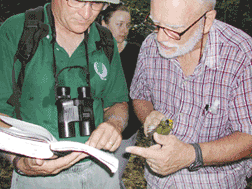 |
Chris Swarth and Mike Quinlan confer on a male hooded warbler. |
Finding Old Friends
Since 1990, Jug Bay has banded almost 2,200 birds of 60 different species. Their summer nets have also recaptured more than 1,100 birds that were previously banded, catching about half of those more than once. By collecting specific information about each bird, scientists gain insight into their habits and needs.
Though years of data from many sites must be studied to correctly interpret nationwide trends, Jug Bay’s results show promise. The woodthrush population is burgeoning. Occasionally, old friends have stopped by.
Ovenbirds, large warblers with a single orange stripe bordered in black on their crowns, fill the late spring and summer woods with their loud crescendo: cher-tee, cher-tee, cher-tee. One ovenbird, first banded at Jug Bay as an adult in 1994, was recaptured in 1996 and 2003, making this repeat visitor at least 10 years old.
Fifteen red-eyed vireos, aged five to eight years, returned to Jug Bay in 2005 to breed. In 2006, a female red-eyed vireo first banded in 1997 was recaptured, as she had been several times before.
“This bird, which weighs about 16 grams or roughly the weight of three nickels and a penny, winters in northern South America some 2,000 miles away,” Teliak said. “She has been going 4,000 miles roundtrip each year for the past 10 years so she can breed at Jug Bay.”
What keeps these birds coming back?
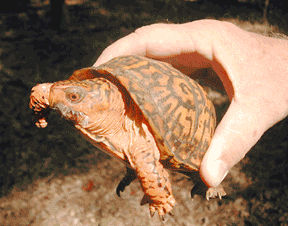 |
The common box turtle has some eating habits that bird banders find unpalatable. “Sometimes,” Sandy Teliak explains, “we have even found a box turtle eating a bird in the net.” |
Most likely, it’s the expansive woodlands. Loss of large parcels of forest can pose real problems for some of these birds. Seventeen years of bird nesting data have shown that ovenbirds are one of the most sensitive of the woodland nesters to reduced forest size. Below 30 hectares, or about 74 acres, their breeding success drops off precipitously.
Half of Jug Bay’s 1,400 acres are wooded, and both the ovenbirds and wood thrushes — who need 20 to 25 hectares — are thriving. Besides adding their songs and beauty to our lives, warblers and thrushes keep the insect population down by eating vast quantities of caterpillars, ants, beetles and other bugs.
Reasons for Returning
Waiting for the last net run before noon, Swarth and I sat on a bench overlooking the marsh. The pale-yellow wild rice barely moved in the humid air. Swarth pointed out a katydid eating one of the male flowers.
“We just began noticing this and want to study it,” he said.
Julia Hagemeyer joined us, looking about with unmasked delight. Pointing to a nearby tree she asked, “What is that?”
Alerted to the white froth on an alder branch, we watched a number of large black ants swarming over the bubbly mass.
“Aphids,” said Swarth. “They draw the juices out of the branch and the ants feed on it; the ants have their own aphid farm.”
“You see something different every time you visit,” continued Swarth. “When you go to a place like Blackwater National Wildlife Refuge, you can be pretty sure what you will see: eagles and herons and waterfowl. But here things are more subtle. You just have to keep coming back.”
A year has passed. Spring blossoms toward summer; migration is underway. It is time to go back. It’s time to hold a bird again.
Volunteers (eight to 10 per day, ages 10 and older) are welcome to join Jug Bay’s Bird Banding Study beginning 6am-noon Thursday, May 24, and continuing through July (Sundays June 3, 24; July 15, 31; Tuesdays: June 12; July 3, 24). Wear sturdy shoes and long pants for hiking on woodland trails. Nets open at 6am; first net run is 6:50am. Volunteers meet at junction of Railroad Bed Trail and Otter Trail at 6:40am. Call 48 hours in advance of banding morning. Mike Quinlan: 301-805-4278; [email protected]; www.jugbay.org.
Dotty Holcomb Doherty of Annapolis is a regular contributor to Bay Weekly, specializing in birds and children. Her last story (Vol. xv, No. 17: April 26) introduced Children’s Theater impresario Jackie Waymire.
|
Current Issue \\ Archives \\ Subscriptions \\ Clasified Advertising \\ Display Advertising |
© COPYRIGHT 2007 by New Bay Enterprises, Inc. All rights reserved.

